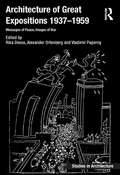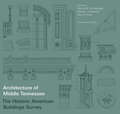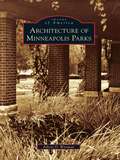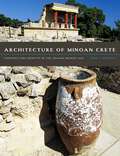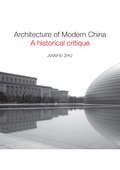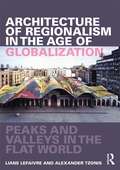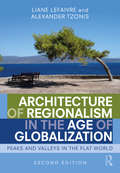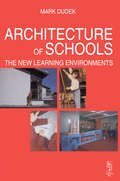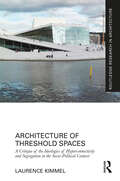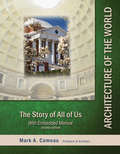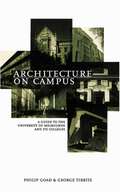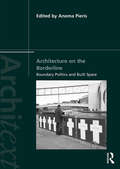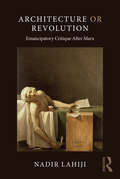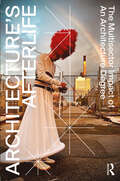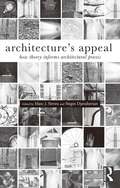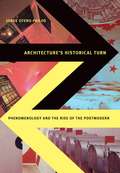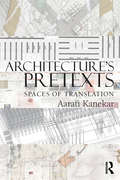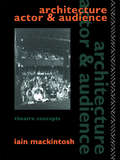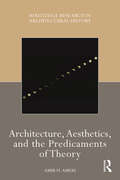- Table View
- List View
Architecture of Great Expositions 1937-1959: Messages of Peace, Images of War (Ashgate Studies in Architecture)
by Alexander Ortenberg Rika DevosThis book investigates architecture as a form of diplomacy in the context of the Second World War at six major European international and national expositions that took place between 1937 and 1959. The volume gives a fascinating account of architecture assuming the role of the carrier of war-related messages, some of them camouflaged while others quite frank. The famous standoffs between the Stalinist Russia and the Nazi Germany in Paris 1937, or the juxtaposition of the USSR and USA pavilions in Brussels 1958, are examples of very explicit shows of force. The book also discusses some less known - and more subtle - messages, revealed through an examination of several additional pavilions in both Paris and Brussels; of a series of expositions in Moscow; of the Universal Exhibition in Rome that was planned to open in 1942; and of London’s South Bank Exposition of 1951: all of them related, in one way or another, to either an anticipation of the global war or to its horrific aftermaths. A brief discussion of three pre-World War II American expositions that are reviewed in the Epilogue supports this point. It indicates a significant difference in the attitude of American exposition commissioners, who were less attuned to the looming war than their European counterparts. The book provides a novel assessment of modern architecture’s involvement with national representation. Whether in the service of Fascist Italy or of Imperial Japan, of Republican Spain or of the post-war Franquista regime, of the French Popular Front or of socialist Yugoslavia, of the arising FRG or of capitalist USA, of Stalinist Russia or of post-colonial Britain, exposition architecture during the period in question was driven by a deep faith in its ability to represent ideology. The book argues that this widespread confidence in architecture’s ability to act as a propaganda tool was one of the reasons why Modernist architecture lent itself to the service of such different masters.
Architecture of Life: Soviet Modernism and the Human Sciences
by Alla VronskayaExplores how Soviet architects reimagined the built environment through the principles of the human sciences During the 1920s and 1930s, proponents of Soviet architecture looked to various principles within the human sciences in their efforts to formulate a methodological and theoretical basis for their modernist project. Architecture of Life delves into the foundations of this transdisciplinary and transnational endeavor, analyzing many facets of their radical approach and situating it within the context of other modernist movements that were developing concurrently across the globe. Examining the theories advanced by El Lissitzky, Moisei Ginzburg, and Nikolay Ladovsky, as well as those of their lesser-known colleagues, this illuminating study demonstrates how Soviet architects of the interwar period sought to mitigate Fordist production methods with other, ostensibly more human-oriented approaches that drew on the biological and psychological sciences. Envisioning the built environment as innately connected to social evolution, their methods incorporated aspects of psychoanalysis, personality theory, and studies in spatial perception, all of which were integrated into an ideology that grounded functional design firmly within the attributes of the individual. A comprehensive overview of the ideals that permeated its expanded project, Architecture of Life explicates the underlying impulses that motivated Soviet modernism, highlighting the deep interconnections among the ways in which it viewed all aspects of life, both natural and manufactured..
Architecture of Middle Tennessee: The Historic American Buildings Survey (Vintage Vanderbilt)
by Aja BainFirst published in 1974, Architecture of Middle Tennessee quickly became a record of some of the region's most important and most endangered buildings. Based primarily upon photographs, measured drawings, and historical and architectural information assembled by the Historic American Buildings Survey of the National Park Service in 1970 and 1971, the book was conceived of as a record of buildings preservationists assumed would soon be lost. Remarkably, though, nearly half a century later, most of the buildings featured in the book are still standing. Vanderbilt staffers discovered a treasure trove of photos and diagrams from the HABS survey that did not make the original edition in the Press archives. This new, expanded edition contains all the original text and images from the first volume, plus many of the forgotten archived materials collected by HABS in the 1970s. In her new introduction to this reissue, Aja Bain discusses why these buildings were saved and wonders about what lessons preservationists can learn now about how to preserve a wider swath of our shared history.
Architecture of Minneapolis Parks (Images of America)
by Albert D. WittmanBuildings, bridges, and much more--these are the treasures in or near Minneapolis parks that are rarely given attention. This book diverts the reader from the traditional park elements of lakes, woods, streams, and playfields and focuses instead on the rich architectural components they offer. Buildings range from the 160-year-old Godfrey house, believed to be the oldest standing house in Minneapolis, to the recently completed shelters in the Wabun picnic area at Minnehaha Park. Many architects, from Stanford White to Harry Jones to Frank Gehry, have left their marks either on parkland or across the street. Some of their notables are presented in this book. One of the most popular icons of Minneapolis, the Lake Harriet Bandstand, with a long list of predecessors and once painted blue, rounds out this presentation.
Architecture of Minoan Crete: Constructing Identity in the Aegean Bronze Age
by John C. McEnroeA comprehensive, scholarly, engaging look at the meanings behind key architectural designs of ancient Minoan culture. Ever since Sir Arthur Evans first excavated at the site of the Palace at Knossos in the early twentieth century, scholars and visitors have been drawn to the architecture of Bronze Age Crete. Much of the attraction comes from the geographical and historical uniqueness of the island. Equidistant from Europe, the Middle East, and Africa, Minoan Crete is on the shifting conceptual border between East and West, and chronologically suspended between history and prehistory. In this culturally dynamic context, architecture provided more than physical shelter; it embodied meaning. Architecture was a medium through which Minoans constructed their notions of social, ethnic, and historical identity: the buildings tell us about how the Minoans saw themselves, and how they wanted to be seen by others.Architecture of Minoan Crete is the first comprehensive study of the entire range of Minoan architecture—including houses, palaces, tombs, and cities—from 7000 BC to 1100 BC. John C. McEnroe synthesizes the vast literature on Minoan Crete, with particular emphasis on the important discoveries of the past twenty years, to provide an up-to-date account of Minoan architecture. His accessible writing style, skillful architectural drawings of houses and palaces, site maps, and color photographs make this book inviting for general readers and visitors to Crete, as well as scholars.
Architecture of Modern China: A Historical Critique
by Jianfei ZhuA collection of essays on architecture of modern China, arranged chronologically covering a period from 1729 to 2008, focusing mainly on the twentieth century. The distinctive feature of this book is a blending of ‘critical’ and ‘historical’ research, taking a long-range perspective transcending the current scene and the Maoist period. This is a short, elegant book that condenses the wide subject matter into key topics.
Architecture of Regionalism in the Age of Globalization: Peaks and Valleys in the Flat World
by Liane Lefaivre Alexander TzonisThe definitive introductory book on the theory and history of regionalist architecture in the context of globalization, this text addresses issues of identity, community, and sustainability along with a selection of the most outstanding examples of design from all over the world. Alex Tzonis and Liane Lefaivre give a readable, vivid, scholarly account of this major conflict as it relates to the design of the human-made environment. Demystifying the reasons behind how globalization enabled creativity and brought about unprecedented wealth but also produced new wastefulness and ecological destruction, the book also looks at how regionalism has also tended to confine, tearing apart societies and promoting destructive consumerist tourism.
Architecture of Regionalism in the Age of Globalization: Peaks and Valleys in the Flat World
by Liane Lefaivre Alexander TzonisThis book remains the definitive introductory text on the theory and history of regionalist architecture in the context of globalization. It addresses issues of identity, diversity, community, inequality, geopolitics, and sustainability. From the authors who coined the concept of Critical Regionalism, this new edition enhances the understanding of the complex evolution of regionalism and its rival, unchecked globalization. Covering a rich selection of the most outstanding examples of design from all over the world, Liane Lefaivre and Alexander Tzonis, who introduced the concept of Critical Regionalism to architecture, present an enlightening, concise historical analysis of the endurance of regionalism and the ceaseless drive for globalization. New case studies include current cutting-edge projects in Japan, Africa, China, and the United States. Architecture of Regionalism in the Age of Globalization offers undergraduate and graduate students of architecture, geography, history, environmental studies, and other related fields an accessible, vivid, and scholarly perspective of this major conflict as it relates to the design and to the future of the human-made environment.
Architecture of Resistance: Cultivating Moments of Possibility within the Palestinian/Israeli Conflict (Design Research in Architecture)
by Yara SharifArchitecture of Resistance investigates the relationship between architecture, politics and power, and how these factors interplay in light of the Palestinian/Israeli conflict. It takes Palestine as the key ground of spatial exploration, looking at the spaces between people, boundary lines, documents and maps in a search for the meaning of architecture of resistance. Stemming from the need for an alternative discourse that can nourish the Palestinian spaces of imagination, the author reinterprets the land from a new perspective, by stripping it of the dominant power of lines to expose the hidden dynamic topography born out of everyday Palestine. It applies a hybrid approach of research through design and visual documentary, through text, illustrations, mapping techniques and collages, to capture the absent local narrative as an essential component of spatial investigation.
Architecture of Schools: The New Learning Environments
by Mark DudekThis is the standard design guide on schools architecture, providing vital information on school architecture. Mark Dudek views school building design as a particularly specialised field encompassing ever changing educational theories, the subtle spatial and psychological requirements of growing children and practical issues that are unique to these types of building. He explores the functional requirements of individual spaces, such as classrooms, and shows how their incorporation within a single institution area are a defining characteristic of the effective educational environment. Acoustics, impact damage, the functional differentiation of spaces such as classrooms, music rooms, craft activities and gymnasium, within a single institution are all dealt with. More esoteric factors such as the effects on behaviour of colour, light, surface texture and imagery are considered in addition to the more practical aspects of designing for comfort and health.Chapter 4 comprises 20 case studies which address those issues important in the creation of modern school settings. They are state of the art examples from all parts of the world. These examples include: Pokstown Down Primary, Bournemouth; Haute Vallee School, Jersey; Heinz-Galinski School, Berlin; Anne Frank School, Papendract, Netherlands; Seabird Island School, British Columbia and The Little Village Academy, Chicago.
Architecture of Threshold Spaces: A Critique of the Ideologies of Hyperconnectivity and Segregation in the Socio-Political Context (Routledge Research in Architecture)
by Laurence KimmelThis book explores the relationship between architecture and philosophy through a discussion on threshold spaces linking public space with publicly accessible buildings. It explores the connection between exterior and interior and how this creates and affects interactions between people and the social dynamics of the city. Building on an existing body of literature, the book engages with critical philosophy and discusses how it can be applied to architecture. In a similar vein to Walter Benjamin’s descriptions of the Parisian Arcades in the nineteenth century, the book identifies the conditions under which thresholds reveal and impact social life. It utilises a wide range of illustrated international case studies from architects in Japan, Norway, Finland, France, Portugal, Italy, the USA, Australia, Mexico, and Brazil. Within the examples, thresholds become enhancers of social interactions and highlight broader socio-political contexts in public and private space. Architecture of Threshold Spaces is an enlightening contribution to knowledge on contemporary architecture, politics and philosophy for students, academics, and architects.
Architecture of the Everyday
by Steven Harris Deborah BerkeOrdinary. Banal. Quotidian. These words are rarely used to praise architecture, but in fact they represent the interest of a growing number of architects looking to the everyday to escape the ever-quickening cycles of consumption and fashion that have reduced architecture to a series of stylistic fads. Architecture of the Everyday makes a plea for an architecture that is emphatically un-monumental, anti-heroic, and unconcerned with formal extravagance. Edited by Deborah Berke and Steven Harris, this collection of writings, photo-essays, and projects describes an architecture that draws strength from its simplicity, use of common materials, and relationship to other fields of study. Topics range from a website that explores the politics of domesticity, to a transformation of the sidewalk in Los Angeles' Little Tokyo, to a discussion of the work of Robert Venturi and Denise Scott Brown. Contributors include Margaret Crawford, Peggy Deamer, Deborah Fausch, Ben Gianni and Mark Robbins, Joan Ockman, Ernest Pascucci, Alan Plattus, and Mary-Ann Ray. Deborah Berke and Steven Harris are currently associate professors of architecture at Yale University, and have their own practices in New York City.
Architecture of the Sacred
by Bonna D. Wescoat Robert G. OusterhoutIn this book, a distinguished team of authors explores the way space, place, architecture and ritual interact to construct sacred experience in the historical cultures of the eastern Mediterranean. Essays address fundamental issues and features that enable buildings to perform as spiritually transformative spaces in ancient Greek, Roman, Jewish, early Christian and Byzantine civilizations. Collectively they demonstrate the multiple ways in which works of architecture and their settings were active agents in the ritual process. Architecture did not merely host events; rather, it magnified and elevated them, interacting with rituals facilitating the construction of ceremony. This book examines comparatively the ways in which ideas and situations generated by the interaction of place, built environment, ritual action and memory contributed to the cultural formulation of the sacred experience in different religious faiths.
Architecture of the World: The Story of All of Us (2nd Edition)
by Mark A. ComeauJust as the design of architecture can be avant-garde while at the same time being reflective, the format contained herein offers a pictorially-centric layout while containing related briefs. As a text book that accompanies the lecture portion of a traditional “ground” course, the details are delivered in the classroom and they come in the form of a semester-long story. To see the figures, hear the stories, and “jot down” notes and highlights, is to retain; retain a visual memory of architecture and correlate the application it has to its cause to be built. <p><p>The author has taught Architecture of the World for almost two decades. Though several books are suggested as recommended readings, there has never been an assigned text book as no one book has been found to deliver the content in a way that parallels the author’s “contagious enthusiasm” for teaching history through stories and experiences. <p><p>The content of this book represents an ongoing accumulation of the author’s experiences, photographs, research, and of course - stories, as lived through travel-study around the world that he has led more than a thousand learners on. It is meant to be more of an album, a record, that along with the live lectures results in a semester-long story of the history of all of us!
Architecture on Campus
by Philip Goad George TibbitsArchitecture on Campus offers a unique insight into the rich array of buildings, public artworks and landscapes of the University of Melbourne. When the university was established in 1853, its founders secured a large and expansive site. It was a shrewd move. The first building, the Quadrangle, was Tudor Gothic and handsome in aspect. It sat like a gentleman's villa in a vast park. Now, 150 years later, the campus is like a city, home to more than 35 000 students and spreading beyond its original boundaries. It is an urban precinct with its own special identity, and its buildings offer an unparalleled chronicle of educational architecture in Australia. Architecture on Campus features over one hundred buildings, complemented by Patrick Bingham Hall's stunning photographs. It is a celebration of the backdrop to the intellectual, social and sporting life of a venerable and distinguished university. This clear and thoughtful guidebook is an invitation to exploration, and the perfect companion for walks.
Architecture on the Borderline: Boundary Politics and Built Space (Architext)
by Anoma PierisArchitecture on the Borderline interrogates space and territory in a turbulent present where nation-state borders are porous to a few but impermeable to many. It asks how these uneven and conflicted social realities are embodied in the physical and material conditions imagined, produced or experienced through architecture and urbanism. Drawing on historical, global examples, this rich collection of essays illustrates how empires, nations and cities expand their frontiers and contest boundaries, but equally how borderline identities of people and places influence or expose these processes. Empirical chapters covering Central Asia, the Asia Pacific region, the American continent, Europe and the Middle East offer multiple critical insights into the ways in which our spatial imagination is contingent on ‘border-thinking’; on the ways of being and navigating frontiers, boundaries and margins, the three themes used to organise their content. The underlying premise of the book is that sensitisation to border conditions can alter our understanding of the static physical spaces that service political or cultural ideologies, and that the view from the periphery opens up new ways of understanding sovereignty. In exploring these various spaces and their transformative subjectivities, this book also reveals the unrelenting precarity of contesting and living on the margins, and related spaces and discourses that are neglected or suppressed.
Architecture or Revolution: Emancipatory Critique After Marx
by Nadir LahijiBy linking building theory to the emancipatory project of critique advanced by radical thinkers in our time, this work investigates the key conceptual and historical elements that culminate in an emancipatory theory of building entitled: 'Toward a philosophy of shelter’. Taking Marx as its only resource, this work proceeds with the conviction that our era is contemporaneous to Marx’s historical era. This means ‘not judging the validity of Marx from the perspective of the historical situation’, but rather, ‘demonstrating the validity of a Marxian perspective for a singular historical situation’, as ours. This work will therefore translate this perspective into seeing the situation of architecture through the eyes of Marx. All those concerned with the predicament in our current condition in which architecture must play a major social role in upholding the universal value of what Alain Badiou calls 'generic humanity' will take an interest in this work. In particular, architects, critics, scholars, and students inside the field of architecture who would be seeking the application of this universal value to a new theory of building will be a welcoming audience for this work.
Architecture since 1400
by Kathleen James-ChakrabortyThe first global history of architecture to give equal attention to Western and non-Western structures and built landscapes, Architecture since 1400 is unprecedented in its range, approach, and insight. From Tenochtitlan&’s Great Pyramid in Mexico City and the Duomo in Florence to Levittown&’s suburban tract housing and the Bird&’s Nest Stadium in Beijing, its coverage includes the world&’s most celebrated structures and spaces along with many examples of more humble vernacular buildings. Lavishly illustrated with more than 300 photographs, plans, and interiors, this book presents key moments and innovations in architectural modernity around the globe. Deftly integrating architectural and social history, Kathleen James-Chakraborty pays particular attention to the motivations of client and architect in the design and construction of environments both sacred and secular: palaces and places of worship as well as such characteristically modern structures as the skyscraper, the department store, and the cinema. She also focuses on the role of patrons and addresses to an unparalleled degree the impact of women in commissioning, creating, and inhabiting the built environment, with Gertrude Jekyll, Lina Bo Bardi, and Zaha Hadid taking their place beside Brunelleschi, Sinan, and Le Corbusier. Making clear that visionary architecture has never been the exclusive domain of the West and recognizing the diversity of those responsible for commissioning, designing, and constructing buildings, Architecture since 1400 provides a sweeping, cross-cultural history of the built environment over six centuries.
Architecture's Afterlife: The Multisector Impact of an Architecture Degree
by Harriet Harriss Roberta Marcaccio Michela Barosio Dag Boutsen Andrea Čeko Haydée De Loof Johan De Walsche Santiago Gomes Mia Roth-Čerina Carla Sentieri Neal Sashore Federica Vannucchi Hanne Van ReuselAlmost 40% of architecture graduates choose not to practise as architects. Instead, by ‘leaving’ their chosen profession, this surprisingly large but vastly overlooked cohort are making significant contributions to a wide range of other sectors, from politics to videogame design, demonstrating that architectural training can be a pathway to roles, and even leadership opportunities, across a variety of other professions.Architecture’s Afterlife is the first book to examine the sectors into which these graduates migrate, and to identify the transferable skills that are learned, but not always taught, in their degree programmes, and that prove most useful in their new careers.The book – a result of a three-year pan-European study funded by Erasmus+ – provides a roadmap for increasing graduate employment, addressing skills shortages across all sectors and adapting curricula to changing professional landscapes. It is therefore essential reading for all those responsible for curriculum design and delivery in architecture and other disciplines, including deans, professors, postgraduate researchers and policy makers, as well as students and professionals seeking to expand their career prospects.
Architecture's Appeal: How Theory Informs Architectural Praxis
by Marc J. Neveu Negin DjavaherianThis collection of previously unpublished essays from a diverse range of well-known scholars and architects builds on the architectural tradition of phenomenological hermeneutics as developed by Dalibor Veseley and Joseph Rykwert and carried on by David Leatherbarrow, Peter Carl and Alberto Pérez-Gómez. Taking an interdisciplinary approach and drawing on ideas from beyond the architectural canon, contributors including Kenneth Frampton, David Leatherbarrow, Juhani Pallasmaa, Karsten Harries, Steven Holl, Indra Kagis McEwen, Paul Emmons, and Louise Pelletier offer new insights and perspectives on questions such as the following: Given the recent fascination with all things digital and novel, what is the role of history and theory in contemporary architectural praxis? Is authentic meaning possible in a technological environment that is so global and interconnected? What is the nature and role of the architect in our shared modern world? How can these questions inform a new model of architectural praxis? Architecture's Appeal is a thought-provoking book which will inspire further scholarly inquiry and act as a basis for discussion in the wider field as well as graduate seminars in architectural theory and history.
Architecture's Historical Turn: Phenomenology and the Rise of the Postmodern
by Jorge Otero-PailosArchitecture&’s Historical Turn traces the hidden history of architectural phenomenology, a movement that reflected a key turning point in the early phases of postmodernism and a legitimating source for those architects who first dared to confront history as an intellectual problem and not merely as a stylistic question. Jorge Otero-Pailos shows how architectural phenomenology radically transformed how architects engaged, theorized, and produced history. In the first critical intellectual account of the movement, Otero-Pailos discusses the contributions of leading members, including Jean Labatut, Charles Moore, Christian Norberg-Schulz, and Kenneth Frampton. For architects maturing after World War II, Otero-Pailos contends, architectural history was a problem rather than a given. Paradoxically, their awareness of modernism&’s historicity led some of them to search for an ahistorical experiential constant that might underpin all architectural expression. They drew from phenomenology, exploring the work of Bachelard, Merleau-Ponty, Heidegger, and Ricoeur, which they translated for architectural audiences. Initially, the concept that experience could be a timeless architectural language provided a unifying intellectual basis for the stylistic pluralism that characterized postmodernism. It helped give theory—especially the theory of architectural history—a new importance over practice. However, as Otero-Pailos makes clear, architectural phenomenologists could not accept the idea of theory as an end in itself. In the mid-1980s they were caught in the contradictory and untenable position of having to formulate their own demotion of theory. Otero-Pailos reveals how, ultimately, the rise of architectural phenomenology played a crucial double role in the rise of postmodernism, creating the antimodern specter of a historical consciousness and offering the modern notion of essential experience as the means to defeat it.
Architecture's New Media: Principles, Theories, and Methods of Computer-Aided Design
by Yehuda E. KalayA comprehensive examination of computer-aided architectural design and its potential effect on architectural design practice, for practitioners, educators, students, and researchers.
Architecture's Pretexts: Spaces of Translation
by Aarati KanekarThe aim of this book is to expose readers to architecture’s pretexts that include literary narratives, film, theatre, painting, music, and ritual, as a bridge between diverse intellectual territories and architecture. It introduces a selection of seminal modern and contemporary architectural projects, their situation within the built environment, and their intellectual and formal situation/context as pretexts and design paradigms. Connections between diverse bodies of information will be cultivated along with the ability to posit consequential relationships for the production of architecture. Architecture’s Pretexts seeks to cultivate a vision for architecture that sponsors operative links between the discipline of architecture and those outside of architecture. Exploring the works of various architects including Guiseppe Terragni, Peter Eisenman, Peter Zumthor, Perry Kulper and Smout Allen, and Rem Koolhaas, this book provides the framework to understanding architecture through the lens of art. Key concepts discussed are: allegories, diagrams, form, material, montage, movement, musical ratios, narrative sequence and representation. A valuable tool, with over 75 black and white illustrations, for students and professionals interested in interdisciplinary methods of design thinking.
Architecture, Actor and Audience (Theatre Concepts)
by Iain MackintoshUnderstanding the theatre space on both the practical and theoretical level is becoming increasingly important to people working in drama, in whatever capacity. Theatre architecture is one of the most vital ingredients of the theatrical experience and one of the least discussed or understood. In Architecture, Actor and Audience Mackintosh explores the contribution the design of a theatre can make to the theatrical experience, and examines the failings of many modern theatres which despite vigorous defence from the architectural establishment remain unpopular with both audiences and theatre people. A fascinating and provocative book.
Architecture, Aesthetics, and the Predicaments of Theory (Routledge Research in Architectural History)
by Amir H AmeriArchitecture, Aesthetics, and the Predicaments of Theory offers a critical analysis of the methodological constants and shared critical strategies in the history of theoretical discourse on Western architecture. Central to these constants is the persistent role of aesthetics as a critical tool for the delimitation of architecture. This book analyzes the unceasing critical role aesthetics is given to play in the discourse of architecture. The book offers a close and critical reading of three seminal texts from three different periods in the history of theoretical discourse on Western architecture—the Renaissance, the Enlightenment, and 19th-century Romanticism. The first text is Leone Battista Alberti's Ten Books on Architecture of 1452, the next Marc-Antoine Laugier’s An Essay on Architecture of 1753, and last, John Ruskin’s The Seven Lamps of Architecture of 1849. Additional influential texts from, among others, the 20th and 21st centuries are engaged with along the way to locate and contextualize the arguments within the broader discursive tradition of Western architecture. The book will interest scholars and students of architecture, architectural history and theory, as well as scholars and students of cultural studies, aesthetic philosophy, art history, literary criticism, and related disciplines.
